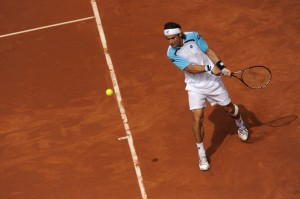Barcelona Open Banc Sabadell, Final
Nadal d. Ferrer, 6/2 6/4
There’s not much to say about the Barcelona final that wasn’t said about the Monte Carlo final. Rafael Nadal sliced David Ferrer to ribbons in both, although we might say that the Barcelona match was less painful, insofar as a fresh razor blade hurts less than a rusty one.  Nadal played better, Ferrer played about the same, and the result was about the same: it felt uncannily like watching a replay, right down to knowing the result ahead of time. For those few who had predicted victory for Ferrer – poor fools lying groaningly prone in an emergency department somewhere – Nadal took only an hour and a half to set them straight. Dominance need not be dull, but, honestly, this is. So far it has been a clay court season only a true fan could love.
Nadal played better, Ferrer played about the same, and the result was about the same: it felt uncannily like watching a replay, right down to knowing the result ahead of time. For those few who had predicted victory for Ferrer – poor fools lying groaningly prone in an emergency department somewhere – Nadal took only an hour and a half to set them straight. Dominance need not be dull, but, honestly, this is. So far it has been a clay court season only a true fan could love.
It has also reinforced my view that Monte Carlo could be safely demoted, and the entire clay swing shifted forward a week, with Barcelona and Monte Carlo running as concurrent 500 events. It would probably be the only way Nadal will stop winning both events, though with careful scheduling he would be the one to pull it off. In any case, that’s not really the point. The point is that these few weeks feel decidedly lightweight, and that it would free up a week after Roland Garros for a grass court Masters in the lead up to Wimbledon. It’s not going to happen, but I’d like it to.
On the topic of resounding structural changes to the tour, arguably the most controversial point to emerge from Barcelona this week has been Nadal revisiting the idea of a two-year ranking system, something that seems to have gone unmentioned since his No.1 ranking was last under serious threat, back in 2009. I am reminded of the tendency of opposition parties to militate for sweeping parliamentary reform, only for it to slip off the agenda once they gain office. In other words, it is self-interest, since a two year system of almost any variety makes it harder for lower players to rise through the ranks, and harder for the top players to fall. To take just one example, under a two year system, Milos Raonic would still be mired outside the top fifty. As it stands, the rankings often only bear a passing relationship to form or ability, and extending the system as Nadal suggests would only alienate them further.
His stated reason for bringing it up is that it would help alleviate wear-and-tear on player’s bodies, though it’s hard to see how that would happen. Those inclined to play a lot still would, merely with diminished returns, and the top players can afford to take longer and more frequent breaks as it is. Nadal himself only played for 22 weeks in 2010, while Federer in his years of utter dominance played between 15-17 tournaments each year. There are plenty of things awry with the system, but this isn’t one of them, and Nadal certainly has the luxury of playing less.
